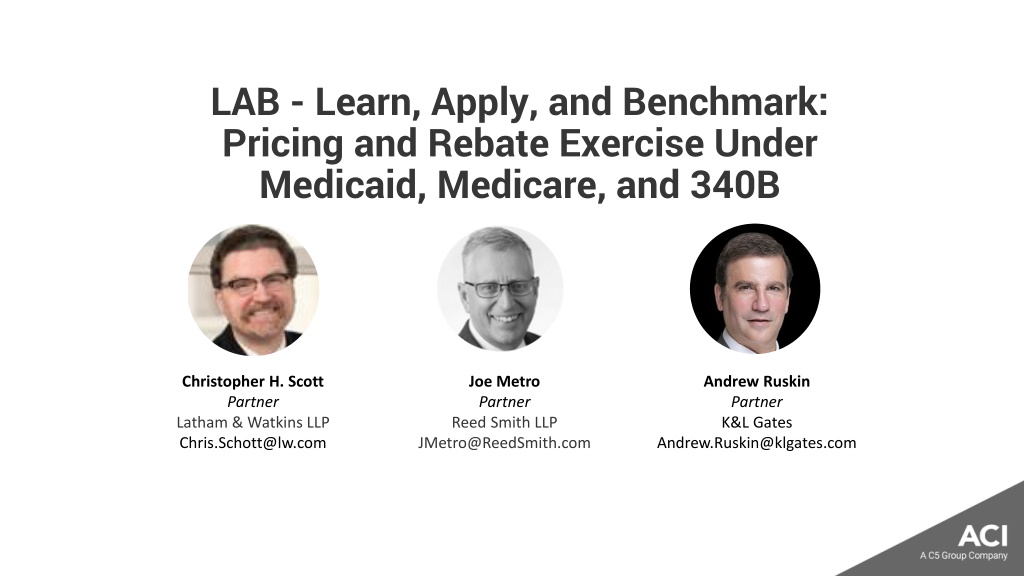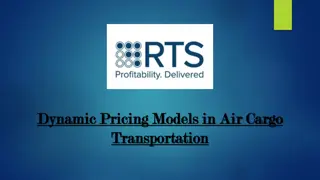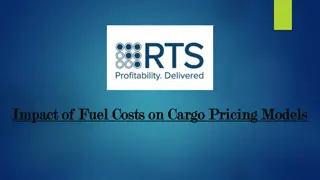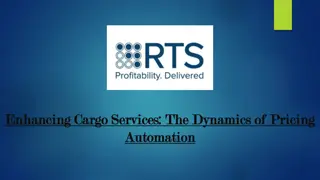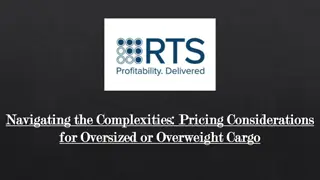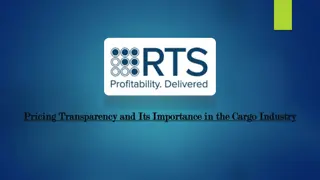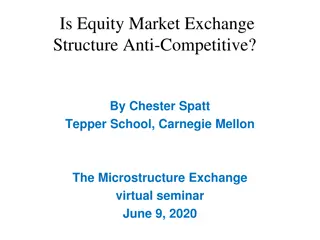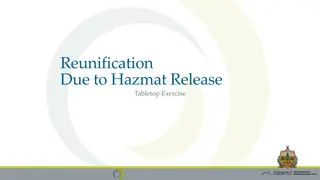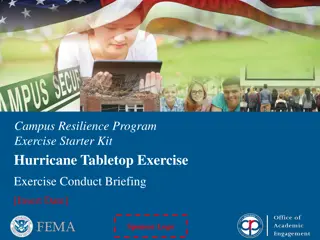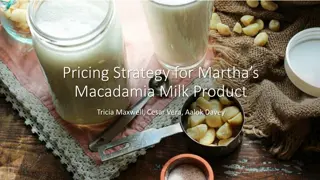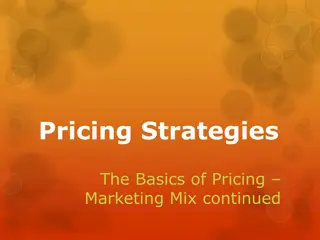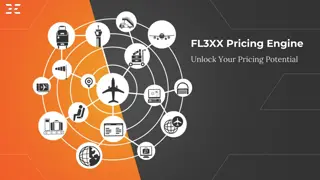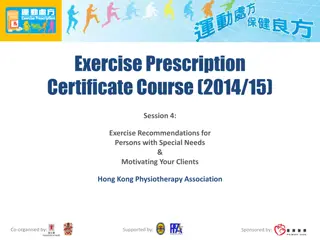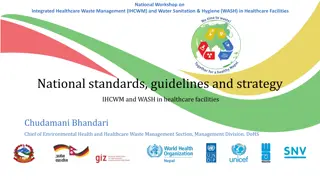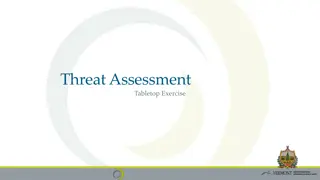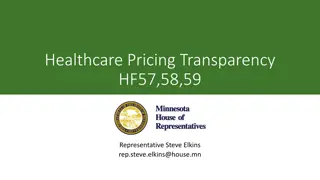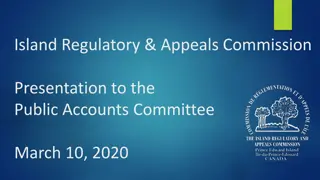Pricing and Rebate Exercise Overview in Healthcare Sector
Delve into a comprehensive analysis of pricing strategies and rebate structures under Medicaid, Medicare, and 340B programs within the healthcare sector. Explore hypothetical drug scenarios, RCP AMP calculations, best price determinations, and basic rebate methodologies. Gain insights into legal perspectives from top industry partners.
Download Presentation

Please find below an Image/Link to download the presentation.
The content on the website is provided AS IS for your information and personal use only. It may not be sold, licensed, or shared on other websites without obtaining consent from the author.If you encounter any issues during the download, it is possible that the publisher has removed the file from their server.
You are allowed to download the files provided on this website for personal or commercial use, subject to the condition that they are used lawfully. All files are the property of their respective owners.
The content on the website is provided AS IS for your information and personal use only. It may not be sold, licensed, or shared on other websites without obtaining consent from the author.
E N D
Presentation Transcript
LAB - Learn, Apply, and Benchmark: Pricing and Rebate Exercise Under Medicaid, Medicare, and 340B Christopher H. Scott Partner Latham & Watkins LLP Chris.Schott@lw.com Joe Metro Partner Reed Smith LLP JMetro@ReedSmith.com Andrew Ruskin Partner K&L Gates Andrew.Ruskin@klgates.com
Agenda Four hypothetical drug scenarios: (1) RCP AMP, BP, and the 340B Ceiling Price (2) 5i AMP and the Not Generally Dispensed Ratio (3) URA for Line Extensions (4) Medicare Part B Questions These presentation materials areprovidedforinformationalpurposesonly anddonot constitute legaladvice ortheviewsor positions Latham & Watkins LLP, K&L Gates LLP or Reed Smith LLP. These presentation materials are intended, but not promised or guaranteed to be current, complete, or up-to-date and should in no way be taken as an indication of future results. Transmission of the information is not intended to create, and the receipt does not constitute, an attorney-client relationship between sender and receiver. The presentation materials are offered only for general informational and educational purposes. They arenot offeredasanddonotconstitutelegaladvice orlegalopinions. Youshould not actorrely onanyinformationcontainedinthesepresentation materials withoutfirstseekingtheadvice of anattorney. 2
Scenario (1): RCP AMP, 5i AMP, and the 340B Ceiling Price 3
Scenario (1): Assumptions Drug: S or I drug BP must be reported One bottle of 100 capsules Medicaid calculations ordinarily occur at the unit (here capsule) level For simplicity, this example calculates at the bottle level Prices: WAC at launch: $8,000 per bottle WAC currently: $9,400 per bottle AMP: The drug is subject to the "traditional" or "Retail Community Pharmacy" (RCP) AMP formula because it is not a 5i drug by route of administration 4
Background: RCP AMP, Best Price, and the Basic Rebate RCPAMP is the average price paid to the manufacturer for its drug in the United States by: (i) wholesalers for drugs distributed to RCPs; and (ii) RCPs that purchase drugs directly from the manufacturer Best Price, generally, is the lowest price to any wholesaler, retailer, provider, HMO, or nonprofit Note: AMP and BP ultimately reported, and rebates calculated, on per unit, rather than per bottle, basis Basic rebate amount equals: BP Calculation: AMP-BP Greater of Minimum Rebate% calculation: AMPxMinimumRebate% 5
Scenario (1): AMP Assume the following discounts Current WAC= $9,400 per bottle Two customers: Distributor and Plan Distributor: 1. Purchase Discount = 2%, or $188 per bottle 2. Prompt Pay Discount (PPD) = 2%, or $188 per bottle Plan: 1.Purchase discount= 5%, or $470 per bottle 2.Performance rebate= 20%, or $1,880 AMP= Eligible dollars divided by eligible units The Plan is ineligible for RCP AMP, so only Distributor dollars and discounts are relevant With respect to Distributor dollars, only purchase discounts are relevant since CPPD are AMP-exempt Assume Distributor purchased 10 units and earned the purchase discount on all units, so that the Distributor paid $92,120 for 10 units (not taking into account prompt pay discounts) Per Bottle AMP = $92,120/ 10 = $9,212 6
Scenario (1): Best Price, Basic Rebate Per Bottle BP= WAC minus all discounts provided to same customer on the same unit Unlike for RCP AMP, the Plan is eligible for BP, and Distributor CPPD discounts affect BP Distributor: $9,400-$188-$188 = $9,024 Plan: $9,400-$470-$1,880 = $7,050 Per Bottle Basic Rebate= Greater of 23.1% of AMP:$ 9,212 x 23.1% = $2,127 AMP minus BP:$ 9,212-$7,050 = $2,162 Role of BP: If BP is more than 23.1% lower than AMP, it impacts the basic rebate; otherwise, it has no impact The Plan sets the BP BP is relevant for the Basic Rebate 7
Background: Additional Rebate An "additional rebate" is added when the drug's quarterly AMP exceeds "base date AMP," as increased by the applicable consumer price index factor (CPI-U) In other words, rebate obligations for drugs increase if the product's AMP increases faster than the rate of inflation Often called the "inflation penalty Formula for calculating the Additional Rebate: 8
Scenario (1): Additional Rebate Base AMP WAC at launch = $8,000 per bottle Example (a): Base AMP= $8,000 because launch terms limited to customary prompt pay to wholesalers and no other discounts were given in base AMP quarter Example (b): Base AMP= $7,500 because launch incentive on-invoice discount of $500 was given in base AMP quarter Base AMP adjusted for inflation Assume rate of inflation since launch is 12% Example (a): $8,000 + 12% = $8,960 Example (b): $7,500 + 12% = $8,400 Inflation penalty calculation for reporting (current) quarter Current AMP= $9,212 Example (a): Additional rebate= ($9,212 - $8,960) = $252 lower rebate Example (b): Additional rebate= ($9,212 - $8,400) = $812 higher rebate The higher base AMP results in a The lower base AMP results in a 9
Scenario (1): Total Rebate (URA) Calculation Unit Rebate Amount = Base Rebate+ Additional Rebate Currently subject to 100% of AMP cap through 4Q2023 Current AMP = $9,212 per bottle Base Rebate= Greater of 23.1% of AMP:$ 9,212 x 23.1% AMP minus BP: $ 9,212 - $7,050 Inflation Penalty Rebate= Example (a): Additional rebate= ($9,212 - $8,960)= $252 = $2,127 = $2,162 Example (b):Additional rebate= ($9,212 - $8,400)= $812 URA= Example (a): $2,162 + $252= $2,414 Example (b): $2,162 + $812 = $2,974 Implications for reporting quarter: Performance rebate made "AMP minus BP" greater than "23.1% of AMP" due to the BP impact, thereby increasing the base rebate by $35 ($2,162, as compared to $2,127) Discount in base AMP quarter increased the additional rebate by $560 ($2,974, as compared to $2,414) ... And this effect will recur each rebate quarter for the life of the drug But note: Recent CPI increases may erode previous Additional Rebate effects and mitigate cap elimination 10
Scenario (1): The 340B Ceiling Price AMP and URA figures (from prior slides): AMP: $9,212 URA Example (a): $2,162 + $252 = $2,414 Example(b): $2,162 + $812 = $2,974 340B Ceiling Price: AMP minus URA Example (a): $9,212 - $2,414 = $6,798 Example (b): $9,212 - $2,974 = $6,238 A higher URA results in a lower 340B ceiling price The significance of a higher URA/lower 340B ceiling price depends on the sales mix of the drug 11
Polling Question #1 Which price represents the lowest price to any wholesaler, retailer, provider, HMO, or nonprofit? A. RCP AMP B. BP C. The Additional Rebate D. The 340B Ceiling Price 12
Scenario (2): 5i AMP and the Not Generally Dispensed Ratio 13
Background: 5i AMP Separate AMP calculation for injectable, infused, implanted, inhaled, or instilled ( 5i") drugs "not generally dispensed" through RCPs Not generally dispensed" means dispensed >70% of the time to non RCPs (directly or through wholesalers) 5i AMP includes those sales (and associated discounts, rebates, payments, or other financial transactions) included in RCP AMP and those to: physicians; PBMs; HMOs; MCOs; insurers; hospitals; clinics and outpatient facilities; mail order pharmacies; long-term care providers; hospices; and "manufacturers, or any other entity that does not conduct business as a wholesaler or [RCP]" 14
Scenario (2): Assumptions Drug: Prescribing Information states -----------DOSAGE AND ADMINISTRATION--------- Market profile: In each month Roughly 65 to 75% of units are sold to Retail Community Pharmacies (RCPs), directly or through wholesalers (WS) Roughly 25 to 35% of units are sold to classes of trade that are not RCPs or WS Is the drug a 5i drug? Yes, because due to its route of administration, it is one of the "inhalation, infusion, instilled, implanted, or injectable" (5i) drugs Once established, this determination remains in place Is the drug subject to the 5i AMP formula? Only if it is "not generally dispensed" to the retail channel, which must be determined every month Instill one drop into the affected eye(s) twice a day. 15
Background: The Not Generally Dispensed Ratio The regulations merely state: "A manufacturer must determine if the 5i drug is not generally dispensed through a [RCP] based on the percentage of sales to entities other than [RCPs]. [] A 5i drug is not generally dispensed through a [RCP] if 70 percent or more of the sales (based on units at the NDC-9 level) of the 5i drug, were to entities other than [RCP] or wholesalers for drugs distributed to [RCPs]." What is the evaluation period? "Over a period of time, such as a 12-month period" How frequently does the evaluation need to be done? Monthly (with quarters based on weighted months) 16
Scenario (2): The NGD Ratio ([Direct Sales Units to RCPs] + ([Direct Sales Units to Wholesalers] - [Indirect Ineligible Sales Units through Wholesalers])) All COT Sales Units The drug is NGD if less than 30% of total units are to the retail channel The NGD ratio indicates the percentage of units sold to the retail channel (RCP and WS) All sales units are determined at the NDC-9 level Hypothetical month: April ([2,500] + [35,000] [12,000]) = 25% Result: The drug is NGD, and the 5i AMP formula applies in April Hypothetical month: May 102,000 ([13,250] + [42,000] - (8,500]) = 32% Result: The drug is not NGD, and the RCP AMP formula applies in May Impact: Because 5i AMP includes many more COTs, it also captures more discounts, and therefore might be lower than RCP AMP Quarterly AMP for Q2: Will be based on the AMP figures for April, May, and June, regardless of which AMP formula applied in each month What are monthly AMP figures used for? 113,000 17
Scenario (3): URA for Line Extensions 18
Scenario (3): Fact Pattern Drug Active Ingredient Dosage Form and Strength Date Manufacturer Reported in MDRP A Alpha 10 ml Vial 2010 Acme Yes B Alphasulphate 20 mg Tablet 2011 Acme Yes C Alpha 30 mg IR Tablet 2012 Acme Yes D Alpha 30 mg Capsule 2013 Acme No E Alpha 10 mg Capsule 2014 Galore Yes F Alpha 30 mg ER Tablet 2015 Acme Yes G Alpha 35 mg ER Tablet 2016 Acme Yes H Alpha Our client is Acme and is asking whether Drug H is a line extension and how to calculate the URA Acme and Galore are unrelated entities Original drug criteria include: 40 mg ER Tablet 2017 Acme Yes 1. 2. 3. 4. 5. Same active ingredient Oral solid dosage form Earlier in time Active in MDRP Same manufacturer/corporate relationship 19
Scenario (3): Potential Original Drugs Drug Active Ingredient Dosage Form and Strength Date Manufacturer Reported in MDRP A Alpha 10 ml Vial 2010 Acme Yes B Alphasulphate 20 mg Tablet 2011 Acme Yes C Alpha 30 mg IR Tablet 2012 Acme Yes D Alpha 30 mg Capsule 2013 Acme No E Alpha 10 mg Capsule 2014 Galore Yes F Alpha 30 mg ER Tablet 2015 Acme Yes G Alpha 35 mg ER Tablet 2016 Acme Yes H Alpha The potential original drugs are C, F, G Would change from quarter to quarter only if the facts change, e.g., Acme purchases Drug E from Galore or merges with Galore, or Acme brings Drug D back to market Which one is the original drug for the reporting quarter? 40 mg ER Tablet 2017 Acme Yes 20
Scenario (3): Identify the Specific Original Drug Drug Additional Rebate AMP Additional Rebate as Percentage of AMP C 200 280 0.7143 F 125 275 0.4545 G 110 270 0.4074 Figures are for the reporting quarter Percentage calculation: [Additional Rebate] / [AMP] Drug C has the highest additional rebate as a percentage of AMP and is the specific original drug for the quarter Would change from quarter to quarter based on AMP and additional rebate fluctuations 21
Background: URA for Line Extensions Ordinary Course URA Formula Basic Rebate of the Line Extension + Additional Rebate of the Line Extension Greater of Alternative URA Formula Greatest Additional Rebate for Any Strength of the Applicable Original Drug, as % of that drug s AMP Basic Rebate of the Line Extension AMP of the Line Extension x + Line extension regulation became effective Jan. 2022 If a drug is a new formulation of an existing drug and other facts exist, the new formulation is a line extension A line extension is subject to an alternative rebate formula that applies the inflation penalty from the applicable original drug to the line extension 22
Scenario (3): Ordinary Course URA for Line Extension Drug H (the line extension): Baseline AMP = 100 Current AMP = 300 Baseline CPI-U (month before baseline quarter) = 170 Current CPI-U (month before current quarter) = 200 BP = 250 Basic Rebate: AMP * 23.1% = 69.30 AMP BP = 50.00 Additional Rebate: AMP [Baseline AMP * Current CPI-U / Baseline CPI-U] = 182.35 23
Scenario (3): Putting it All Together Ordinary Course URA Formula Basic Rebate of the Line Extension = 69.30 + = 251.65 Additional Rebate of the Line Extension = 182.35 Greater of Alternative URA Formula Greatest Additional Rebate for Any Strength of the Applicable Original Drug, as % of that drug s AMP = 0.7143 AMP of the Line Extension = 300 Basic Rebate of the Line Extension = 69.30 x + = 283.59 Figures were taken from the preamble of a 2019 CMS regulation: https://www.govinfo.gov/content/pkg/FR-2019-04-01/pdf/2019-06274.pdf Implications: Launching the line extension at a lower price than the original drug(s) may still trigger the alternative URA Older drugs still on the market? Return on investment in innovation? 24
Scenario (4): Medicare Part B 25
Background: ASP Calculation ASP defined as manufacturer's sales to all purchasers (excluding sales exempt from Medicaid Drug Rebate Program's Best Price calculations and sales at a "nominal price") divided by the total number of units sold "Unit" defined as product represented by 11-digit NDC "Nominal price" defined via regulation by reference to Medicaid Drug Rebate Program's definition By statute, following price concessions must be included in ASP (i.e., ASP is reduced by): Prompt pay discounts Cash discounts Volume discounts Chargebacks Rebates (other than Medicaid rebates} Free goods contingent on a purchase requirement 26
Scenario (4): Manufacturer-Reported ASP Assume the following discounts Drug has a single NDC-11, which refers to a single vial Current WAC= $9,400 per vial (for simplicity, assumes ASP reporting/reimbursement is at the vial level) Two customers: Distributor and Hospital System Distributor: 1. Prompt Pay Discount (PPD) = 2%, or $188 per vial 2. Purchase Discount = 2%, or $188 per vial, for a net price of $9,024 Hospital System: 1. Purchase discount= 5%, or $470 per vial 2. Performance rebate = 20%, or $1,880 o Assuming the rebate was achieved, the per vial price is $7,050 o Note: For simplicity, assumes no smoothing of lagged price concessions ASP= Eligible dollars divided by eligible units ASP captures "sales to all purchasers" (subject to certain exclusions), and so both the Distributor and Hospital System dollars and discounts are relevant (note the similarity with 5i AMP), and Distributor PPD is relevant Assume Distributor purchased 10 vials and earned the PPD on all vials, so that the Distributor paid $9,0240 for 10 vials Assume Hospital System purchased 10 vials and earned the purchase discount and performance rebate on all vials, so that the Hospital System paid $70,500 for 10 vials Per vial ASP= ($90,240 + $70,500)/ (10 + 10) = $8,037 27
Scenario (4): ASP-Based Reimbursement Rate Reimbursement is at the HCPCS code level, and is currently set at ASP + 6% Sequestration reduces the reimbursement by 2% The HCPCS-code reimbursement is based on the volume-weighted ASP figures reported for all the NDC-11s in the code Single source drugs The HCPCS code includes the NDC-11s of the drug, typically all reported by the same single manufacturer Inserting the ASP and unit figures for the hypothetical single NDC-11 drug into the formula generates a volume- weighted ASP equal to the reported ASP, resulting in the following reimbursement amount $8,037 + 6% = $8,131 + $388.22 = $8,519.22 Note that this is less than the acquisition cost paid by the Distributor (which was $9,024) Multiple source drugs The HCPCS code includes the NDC-11s of all related drugs This means that an individual manufacturer cannot predict the Part B reimbursement amount for the code, as it is based on a volume-weighted ASP figure reflecting the ASP and unit figures reported by all manufacturers with NDC- 11s in the HCPCS code 28
Scenario (4): The Two-Quarter Lag The Part B reimbursement rate is based on the ASP figures reported two quarters prior The two-quarter lag has implications for drug pricing strategies 29
Polling Question #2 Which of the following is true regarding ASP? A. It is calculated at the NDC-9 B. It is utilized to calculate rebate amounts for Medicare Part B C. Reimbursement is currently set at ASP + 6% D. It does not include price concessions 30
Please submit your questions in the Session Chat box on the right or reach out to the presenters separately. Christopher H. Scott Partner Latham & Watkins LLP Chris.Schott@lw.com Joe Metro Partner Reed Smith LLP JMetro@ReedSmith.com Andrew Ruskin Partner K&L Gates Andrew.Ruskin@klgates.com
